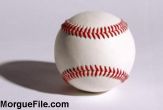How Baseball Players Catch Fly Balls

Every Little League outfielder knows the feeling.
With the crack of the bat, you see the ball jump into the air. You take a few quick steps forward. Then, as you watch the ball continue to rise faster, you feel your stomach sink knowing that this one is going over your head. What went wrong?
How our eyes, brains, arms and legs combine to track and catch a fly ball has stumped scientists for more than 40 years.
A new study supports the original theory of it all while offering some practical tips. By watching fielders shag pop flies, researchers have noticed a few interesting quirks. First, great ballplayers will not sprint to the exact spot on the field where they think the ball will land and then wait for it. Rather, they usually adjust their speed to arrive at the landing spot just as the ball arrives.
In fact, a previous study asked fielders to stand still in the outfield and predict where a fly ball will land. While they did poorly on that test, they then demonstrated that, when allowed to move, they were able to go catch similar fly balls. So, the tracking and prediction mechanism seemed to require movement of the player. Years ago, physicist Seville Chapman proposed a model to explain how players manage the path of a fly ball so that they arrive to intercept it at just the right time. His theory, called Optical Acceleration Cancellation (OAC), used the acceleration of the ball through the vision field as a guide for player movement.
As a fielder watches the ball rise, he moves either forward or backwards so that the ball moves at a constant speed through his field of vision. If he moves too far forward, the ball will rise faster and may eventually fly over his head. If he takes too many steps back, the ball will appear to rise slower and will drop in front of him.
By managing the ball's position with his movement, a fielder will end up at the right spot at the right time. This explains why the stationary fielders could not predict where the ball would land, as they did not have the benefit of OAC. If we ask real fielders how they knew where to run to catch a ball, they may not respond with, "Well, I simply adjusted my relative field position to keep the tangent of the vertical optical angle to the ball increasing at a constant rate." So, to test the OAC geometric equations against real life, researchers led by Dinant Kistemaker of the University of Western Ontario, compared the predicted running paths from their mathematical simulation with the real running paths of fielders observed in a previous study.
Get the world’s most fascinating discoveries delivered straight to your inbox.
"We have found that running paths are largely consistent with those observed experimentally," Kistemaker told LiveScience. "Largely, and not completely, because the start of fielders is somewhat strange: They tend to step forward first, irrespective of the fact that they have run either forward or backwards to catch that fly ball."
The research is detailed this month in the journal Human Movement Science. Will those first few steps forward doom the Little Leaguer to years of fly ball nightmares? Actually, it might be our brain's method of improving its viewpoint.
"For a fielder, making a step is a way of changing the magnitude of the optical acceleration, while preserving its informative value," Kistemaker clarified. "A faster rise of the optical acceleration above the detection threshold may outweigh a possible initial step in the wrong direction. Making an initial step forwards is not only easier than making an initial step backwards, but might also be a better choice." So, if you're now coaching Little Leaguers, be patient. Their brains may still be learning the math.
- Why Kids Can't Hit Slow Pitches
- Video - How To Throw a Split Finger Fastball
- Study Reveals Baseball's Great Clutch Hitters
Dan Peterson writes about sports science at his site Sports Are 80 Percent Mental. His Science of Sports column appears weekly on LiveScience.


